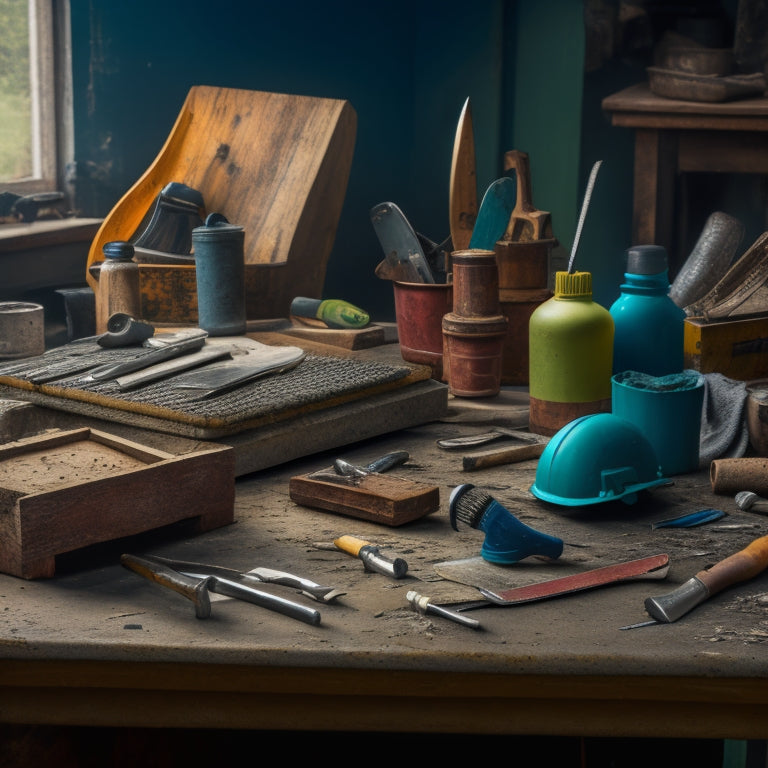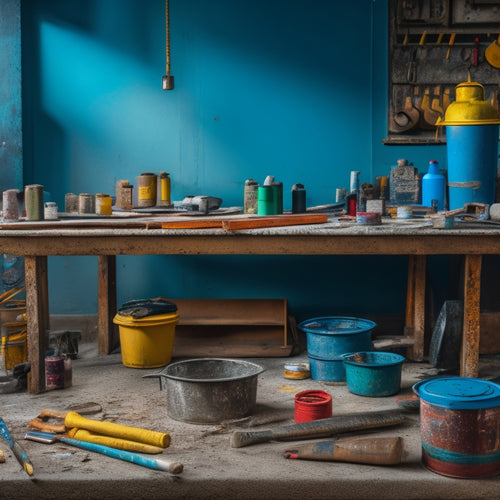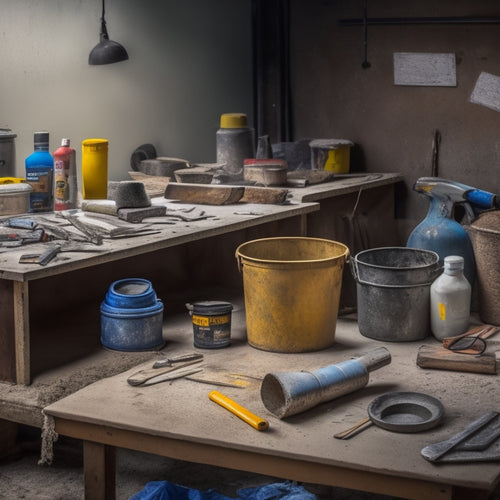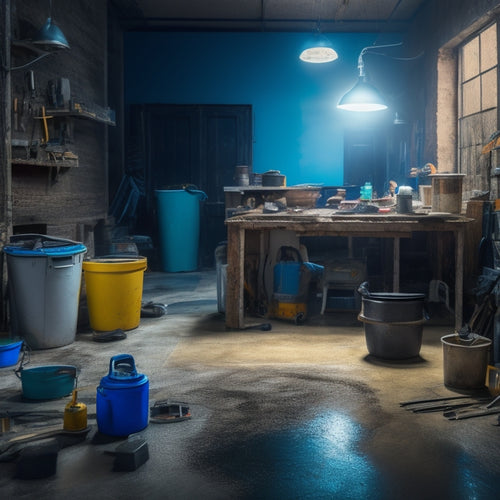
Must-Have Handheld Tools for Concrete Repair
Share
When tackling a concrete repair project, it is crucial to have the right handheld tools to achieve a professional finish and work efficiently. You'll need a hammer and chisel for breaking and chiseling damaged areas, trowels for smoothing and finishing surfaces, and utility knives for making precise cuts. Handheld grinders are perfect for polishing in tight spaces, while concrete scrapers and wire brushes help with surface preparation and cleaning. Don't forget putty knives for applying fillers, caulk guns for sealing joints, and levels for ensuring accuracy. Now that you have the essentials, it's time to learn how to master these tools to take your concrete repair skills to the next level.
Key Takeaways
• A hammer and chisel are essential for breaking up damaged areas in concrete repair, with the right combination enhancing efficiency.
• Trowels are necessary for achieving a professional finish on concrete surfaces, with steel trowels suitable for sharp edges and resin trowels for rounded edges.
• Utility knives with ideal blade angles and maintenance are crucial for clean, controlled cuts, while cutting depth control prevents damage to surrounding concrete.
• Ergonomic handles with secure grip materials enhance control and reduce fatigue, with contoured handles and non-slip coatings improving precision.
• Handheld grinders, concrete scrapers, and wire brushes are must-haves for surface preparation and cleaning, with proper techniques and tool selection ensuring optimal results.
Hammer for Chiseling Concrete
When tackling concrete repair, you'll likely need a hammer for chiseling concrete to break up damaged areas and remove deteriorated material. A hammer is an essential tool for concrete repair, and selecting the right one is vital for effective chiseling.
You'll want to take into account the weight of the hammer, as it directly affects the force you can apply to the concrete. A heavier hammer will provide more force, but may be more difficult to handle for extended periods.
Concrete chisel selection is also critical, as different chisels are designed for specific tasks. For example, a point chisel is ideal for breaking up small areas of concrete, while a flat chisel is better suited for removing larger sections.
When choosing a chisel, think about the type of concrete you're working with, as well as the level of damage. By selecting the right hammer and chisel combination, you'll be able to efficiently break up and remove damaged concrete, preparing the surface for repair.
Trowels for Smoothing Surfaces
When you're working on a concrete repair project, you'll need to use a trowel to smooth out the surface and achieve a professional finish.
You'll focus on creating sharp, defined edges and a uniform surface by holding the trowel at a 45-degree angle and applying gentle to moderate pressure.
Concrete Finishing Edges
You'll typically reach for a trowel to smooth out freshly poured concrete surfaces, ensuring a uniform finish and preventing imperfections from setting in. As you work, you'll need to evaluate the type of concrete edge style you're aiming for, as this will influence your finishing techniques.
Are you going for a sharp, defined edge or a more rounded, bullnose finish? The style you choose will dictate the type of trowel you use and the techniques you employ. For example, a steel trowel is ideal for creating sharp edges, while a resin or polyurethane trowel is better suited for rounded edges.
When working with curved or irregular edges, you may need to use a combination of trowels and specialized tools, such as edgers or floats, to achieve the desired finish. By mastering the art of concrete finishing edges, you'll be able to produce professional-looking results that meet the highest standards of quality and aesthetics.
With the right tools and techniques, you'll be able to tackle even the most complex concrete repair projects with confidence.
Smooth Surface Creation
To achieve a smooth, even surface, you're likely to reach for a trowel, a handheld tool specifically designed to flatten and refine freshly poured concrete. As a master of concrete repair, you know that surface preparation techniques are essential to a successful project. That's why you'll want to choose the right trowel for the job. Look for one with a sturdy handle and a high-carbon steel blade that can withstand the rigors of concrete mixing essentials.
When using your trowel, start by holding it at a 45-degree angle to the surface. Apply gentle to moderate pressure, depending on the consistency of the concrete, and move the trowel in smooth, even strokes. This will help to remove any excess material and create a smooth, even surface.
Be sure to work in small sections, as this will allow you to maintain control and achieve the desired finish. By mastering the art of troweling, you'll be able to create surfaces that are both functional and aesthetically pleasing.
With the right techniques and tools, you'll be well on your way to becoming a concrete repair expert.
Even Finish Achievement
By selecting a trowel with a curved or angled blade, you can achieve an even finish on surfaces with complex geometries or tight corners. This is particularly important when working with concrete repairs, where a uniform texture is vital for both aesthetics and durability.
When it comes to texture enhancement, the right trowel can make all the difference. A curved blade allows you to feather out edges and blend repairs seamlessly with the surrounding surface, while an angled blade provides extra leverage for reaching into tight spaces.
Proper surface preparation is also key to a successful concrete repair. A high-quality trowel helps you achieve a smooth, even surface that's ready for finishing coats or overlays.
Utility Knives for Cutting
When you're selecting a utility knife for cutting concrete, you'll want to reflect on a few key factors that'll make a big difference in your results.
You'll need to think about the ideal blade angle for your specific task, as well as how to control the cutting depth to avoid damaging the surrounding material.
Blade Angle Matters
You hold the utility knife at a precise 20- to 30-degree angle to guarantee a clean, controlled cut in the concrete. This angle adjustment is essential, as it allows you to make accurate cuts without applying excessive pressure, which can lead to blade damage or breakage.
When you maintain the ideal blade angle, you'll experience reduced fatigue and improved cutting efficiency. Remember, a dull blade can compromise your cut quality, so prioritize blade maintenance tips like regular cleaning and honing to extend its lifespan.
Adjusting the blade angle also helps you navigate varying concrete densities and surfaces. For instance, a slightly steeper angle might be needed for denser concrete, while a shallower angle is better suited for softer or more porous surfaces.
Cutting Depth Control
To achieve precise cuts and prevent damage to the surrounding concrete, mastering cutting depth control with your utility knife is just as important as adjusting the blade angle.
You'll need to develop a keen sense of cutting techniques and learn to make precise depth adjustments. Start by setting the blade to the desired depth, taking into account the type of concrete you're working with and the specific repair task at hand.
As you make your cuts, pay close attention to the blade's progression and adjust the depth as needed. Practice will help you develop a feel for the ideal cutting depth, but it's crucial to remain vigilant and make adjustments on the fly.
Handle Ergonomics Count
A utility knife's handle ergonomics play an essential role in reducing fatigue and discomfort, allowing you to focus on making precise cuts and achieving professional results.
When choosing a utility knife for concrete repair, you should consider a handle that provides ideal comfort and support. Look for grip materials that offer a secure hold, even with gloved hands or in wet conditions. A contoured handle with a non-slip coating can make a significant difference in your ability to maintain control and precision.
A comfortable handle also reduces the strain on your hand and wrist, enabling you to work for extended periods without fatigue. Additionally, an ergonomic handle design should allow for easy blade changes and minimal obstruction to your cutting path.
When evaluating a utility knife's handle ergonomics, consider factors such as handle shape, size, and material, as well as the overall balance and weight distribution of the tool.
Handheld Grinders for Polishing
Handheld Grinders for Polishing
Most concrete repair professionals turn to handheld grinders for polishing because they offer unparalleled versatility and accessibility in tight spaces. When it comes to polishing, you'll want to focus on achieving a high-gloss finish while ensuring grinder safety.
Always wear protective gear, including gloves, safety glasses, and a dust mask. Keep your work area well-ventilated to prevent inhaling dust and debris.
To master polishing techniques, start with a coarse grit (around 16-24) and progressively move to finer grits (up to 120-150) for a high-shine finish. Use a consistent, overlapping pattern to avoid scratches and swirl marks.
Apply moderate to light pressure, depending on the concrete's hardness and the grinder's power. For best results, maintain a steady pace and avoid applying too much pressure, which can lead to overheating and damage to the grinder or concrete.
Concrete Scrapers for Removing
Efficient removal of old coatings, adhesives, and surface imperfections requires a reliable concrete scraper that can withstand the rigors of heavy-duty use. As you prepare to tackle concrete surface preparation, you'll want a scraper that can handle the toughest jobs. When choosing a scraper, consider the type of material you're removing, the surface roughness, and the desired finish.
Here are some key factors to keep in mind:
| Factor | Consideration |
|---|---|
| Material | Remove old coatings, adhesives, or imperfections without damaging the concrete |
| Blade Type | Choose from flat, curved, or angled blades for ideal scraping performance |
| Handle Material | Durable materials like fiberglass or steel guarantee a comfortable grip and reduced fatigue |
| Ergonomic Design | Look for contoured handles and balanced weight distribution for effective scraper techniques |
Wire Brushes for Cleaning
You'll need wire brushes with stiff bristles to aggressively scrub away dirt, grime, and loose particles from the concrete surface, preparing it for repair. When selecting a wire brush, consider the type of bristles and their stiffness. For example, stainless steel bristles are ideal for cleaning rough surfaces, while softer brass bristles are better suited for smoother surfaces.
There are various wire brush types to choose from, including flat, round, and angled brushes, each designed for specific cleaning tasks. For instance, flat wire brushes are perfect for cleaning large, flat areas, while round wire brushes are ideal for getting into tight spaces and corners. Angled wire brushes, on the other hand, are great for cleaning edges and crevices.
When it comes to cleaning techniques, use a gentle to moderate scrubbing motion, depending on the surface and the level of dirt and grime. Avoid using excessive force, as this can damage the concrete. Work in small sections, cleaning one area at a time, to guarantee a thorough job. By using the right wire brush and cleaning technique, you'll be able to effectively remove dirt and debris, creating a clean surface for repair.
Putty Knives for Applying Fillers
When applying fillers to repair cracks and holes in concrete, a putty knife is the ideal tool for spreading and smoothing the material into place.
You'll find that it's essential for achieving a seamless finish. To get the most out of your putty knife, master these techniques: hold the knife at a 20-degree angle to the concrete surface, using long, smooth strokes to spread the filler evenly.
Apply gentle to moderate pressure, depending on the filler's consistency. For deeper cracks, use a putty knife with a stiffer blade to force the filler into the gap. For smaller areas, switch to a more flexible blade for greater control.
When it comes to filler application tips, remember to work in small sections, about 2-3 inches at a time. This will help you maintain even coverage and avoid excessive buildup.
Also, make sure the filler is mixed to the manufacturer's specifications, as an incorrect ratio can lead to uneven drying or poor adhesion.
Caulk Guns for Sealing Joints
After filling cracks and holes with a putty knife, you're ready to seal the joints with a caulk gun, guaranteeing a watertight seal that prevents further damage.
When selecting a caulk, consider the type of joint you're working with. For example, silicone-based caulks are ideal for joints that require high flexibility, such as those subject to vibration or movement. Acrylic-based caulks, on the other hand, are better suited for joints with minimal movement.
When using a caulk gun, make sure to hold it at a 45-degree angle, applying even pressure to guarantee a consistent bead. It's crucial to maintain a steady flow of caulk to prevent air pockets from forming.
As you move along the joint, use a damp cloth or tool to smooth out the caulk, feathering it out towards the edges. This will help create a strong, watertight seal.
Levels for Ensuring Accuracy
Accurate leveling is essential in concrete repair, and a reliable level guarantees that your surfaces are perfectly aligned, preventing unevenness that can lead to further damage or compromised structural integrity.
You can't afford to compromise on level accuracy, as it directly impacts the quality of your repair work.
When choosing a level, you'll come across various types, each with its unique features and benefits. Here are four essential level types to contemplate:
-
Spirit levels: Ideal for checking surfaces, spirit levels use a bubble to indicate when the surface is level.
-
Laser levels: Projecting a level line or dot, laser levels are perfect for larger surfaces and long-distance leveling.
-
Digital levels: Providing precise digital readings, digital levels are great for measuring angles and slopes.
- Torpedo levels: Compact and versatile, torpedo levels are designed for tight spaces and one-handed operation.
Investing in a high-quality level guarantees that your concrete repairs meet the highest standards.
Frequently Asked Questions
What Safety Gear Is Necessary for Concrete Repair Projects?
When tackling concrete repair projects, you'll need to prioritize your safety above all else.
You'll require essential safety gear to protect yourself from hazardous materials and harsh conditions.
Invest in high-quality protective equipment like heavy-duty gloves, safety glasses, and a dust mask to prevent skin and eye irritation.
Don't forget a hard hat and steel-toed boots to safeguard against falling objects and heavy tools.
Can I Use Handheld Tools for Large-Scale Concrete Repair?
You're trying to scale a mountain with a pocket knife, wondering if handheld tools can tackle large-scale concrete repair projects.
While they're perfect for smaller tasks, handheld tools can be inefficient for massive jobs.
You'll face challenges like slower progress, operator fatigue, and increased labor costs.
For large-scale projects, it's better to bring in the heavy artillery – specialized equipment designed for heavy-duty concrete repair.
How Do I Maintain and Clean My Handheld Tools?
You'll extend the lifespan of your handheld tools by establishing a maintenance schedule and proper tool storage.
Regularly inspect your tools for signs of wear, clean them after each use, and apply lubricants as needed.
Store them in a dry, organized space, away from direct sunlight.
Set reminders to check and update your tools every 3-6 months to guarantee they remain in top condition.
Are There Any Specific Tool Brands Recommended for Concrete Repair?
Coincidentally, you're not alone in wondering about reliable tool brands for concrete repair. You're probably scouring the market for the best fit.
When comparing tool brands, you'll find that user experience reviews are invaluable. Look for brands like DeWalt, Bosch, and Makita, known for their durability and performance.
Read reviews from professionals and DIYers alike to get a sense of each brand's strengths and weaknesses. By doing your research, you'll find the perfect tool brand to suit your concrete repair needs.
Can I Rent Handheld Tools for a One-Time Concrete Repair Project?
When tackling a one-time concrete repair project, you'll want to evaluate tool rental options to minimize upfront costs.
Weigh the project cost considerations: buying tools mightn't be justified for a single use.
Look into local equipment rental stores or online platforms that offer concrete repair tool rentals.
This approach will help you access the necessary tools without breaking the bank, ensuring your project stays on budget.
Conclusion
As you wrap up your concrete repair project, remember that having the right tools is essential to achieving professional-looking results.
Did you know that according to the American Concrete Institute, the concrete repair industry is projected to reach $3.2 billion by 2025?
With the must-have handheld tools mentioned above, you'll be well-equipped to capitalize on this growing trend.
By investing in these essentials, you'll save time, reduce errors, and deliver high-quality results that will leave your clients impressed.
Related Posts
-

Essential Tools for Painting Concrete Walls
When painting concrete walls, you'll need a range of specialized tools to achieve a professional-looking finish. Star...
-

3 Best Tools to Buy for Concrete Repair Online
When buying tools for concrete repair online, you'll want to research multiple retailer options to find the best prod...
-

Essential Tools for Epoxy Concrete Floor Repair
You'll need a thorough arsenal of specialized tools to guarantee a successful epoxy concrete floor repair. Floor prep...


